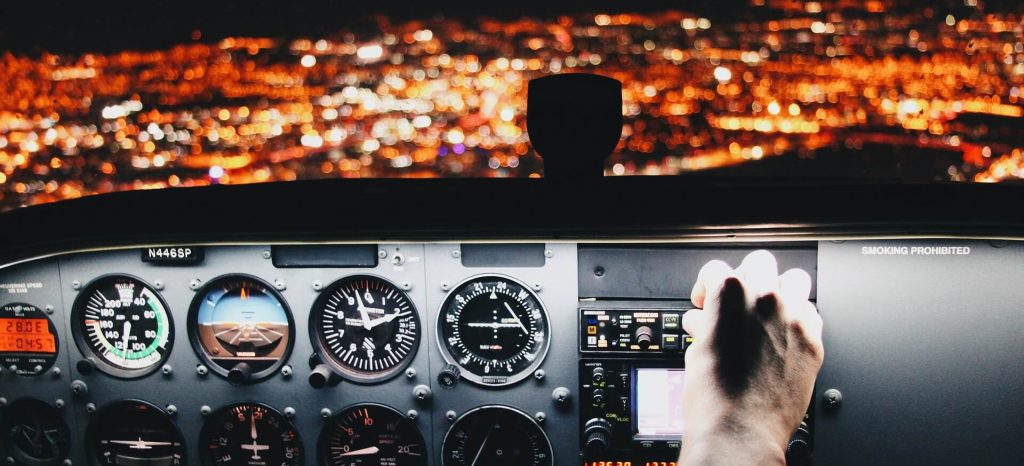Student-centric advice and objective recommendations
Higher education has never been more confusing or expensive. Our goal is to help you navigate the very big decisions related to higher ed with objective information and expert advice. Each piece of content on the site is original, based on extensive research, and reviewed by multiple editors, including a subject matter expert. This ensures that all of our content is up-to-date, useful, accurate, and thorough.
Our reviews and recommendations are based on extensive research, testing, and feedback. We may receive commission from links on our website, but that doesn’t affect our editors’ opinions. Our marketing partners don’t review, approve or endorse our editorial content. It’s accurate to the best of our knowledge when posted. You can find a complete list of our partners here.
How to Become a Pilot
 By
Zach Skillings
By
Zach Skillings 
Zach Skillings is the Scholarships360 Newsletter Editor. He specializes in college admissions and strives to answer important questions about higher education. When he’s not contributing to Scholarships360, Zach writes about travel, music, film, and culture. His work has been published in Our State Magazine, Ladygunn Magazine, The Nocturnal Times, and The Lexington Dispatch. Zach graduated from Elon University with a degree in Cinema and Television Arts.
Full BioLearn about our editorial policies

Maria Geiger is Director of Content at Scholarships360. She is a former online educational technology instructor and adjunct writing instructor. In addition to education reform, Maria’s interests include viewpoint diversity, blended/flipped learning, digital communication, and integrating media/web tools into the curriculum to better facilitate student engagement. Maria earned both a B.A. and an M.A. in English Literature from Monmouth University, an M. Ed. in Education from Monmouth University, and a Virtual Online Teaching Certificate (VOLT) from the University of Pennsylvania.
Full BioLearn about our editorial policies

Few professions give you the chance to see the world from the sky. If you could picture yourself flying a plane for a living, you may want to consider becoming an airline or commercial pilot. Working as a pilot is a unique and rewarding job that also comes with a great salary and generous benefits. If you’re excited by the thought of getting paid to fly, read on to learn how to become a pilot.
Why become a pilot?
Travel
There’s many reasons to pursue a career as a pilot. By the very nature of the job, pilots get to travel around the world. While much of their time is spent in airports or hotels, pilots still get the chance to see new cities and experience other cultures. Besides traveling for business, pilots and their families receive free travel passes they can use for vacations. They also receive generous amounts of paid vacation time. As they build seniority, pilots gain the opportunity to create their own schedules. It’s common for pilots to have flexible schedules that allow for a week or two off every month.
High Salary
Not only do pilots enjoy a certain sense of freedom, but they also earn a high salary. According to the U.S. Bureau of Labor Statistics, airline and commercial pilots receive a median annual pay of $148,900 per year. Most pilots also receive competitive benefits including health, life, vision, and dental insurance. Retirement plans are typically very generous and sometimes include free travel passes for life. Jobs in the industry expect 5% growth this decade, meaning there will be a demand for more pilots in coming years.
Importance
While becoming a pilot is certainly a rewarding career path, it also comes with big responsibilities. Pilots must be skillful and trustworthy to ensure the safety of their passengers. They must be able to react to emergency situations quickly and calmly, address breakdowns in airplane machinery, and navigate unanticipated storms. Flying a plane requires a high degree of courage, competence, and confidence.
What types of pilots are there?
Before we discuss how to become a pilot, it’s important to understand that there are different levels of flying. Generally speaking, there are three main types of pilots:
1. Private pilots
Private pilots are legally certified to operate aircraft, but they’re not eligible to be compensated for flying. They fly just for the fun of it, or they may use their aircraft as a mode of transportation. It generally takes 40 hours of flight time to earn a private pilot certificate.
2. Commercial pilots
Commercial pilots are paid to fly. Getting your commercial pilot certificate qualifies you for a variety of jobs in the aviation industry. Commercial pilots are often hired to fly cargo planes, corporate jets, charter planes, and aircraft ferries. They may also work as flight instructors and teach others how to fly. It generally takes 250 hours of flight time to earn a commercial pilot certificate.
3. Airline pilots
Commercial airline pilots work for regional and major airlines. There are currently about 5,000 airlines around the world. To become an airline pilot, you must accumulate 1,500 hours of flight time and earn your Airline Transport Pilot (ATP) certificate. You must first possess your private pilot certificate and your commercial pilot certificate.
Becoming a private pilot
If you’re looking to pursue a career in aviation, you’ll have to start by earning your private pilot certificate. Let’s break down the steps to becoming a private pilot:
1. Find a flight training option
The first step is to research your flight training options. You can attend either a Part 61 flight school, a Part 141 flight school, or a four-year college or university with an aviation program. Part 61 flight schools are less structured, more flexible in terms of curriculum, and ideal for part-time students. These schools are common among students who are not looking to advance beyond their private pilot certificate.
Part 141 schools are more formal, follow an FAA-approved curriculum, and are generally full-time flight academies. There’s also a variety of traditional colleges and universities that offer bachelor’s degrees in aviation. Students pursuing a career as a pilot usually pick one of these two options, instead of attending a Part 61 school. If you’re pursuing work as a commercial pilot, Part 141 flight schools are great training options. But if your goal is to eventually become an airline pilot, you’ll benefit from attending a four-year college. While a bachelor’s degree isn’t required to become a pilot, many major airlines strongly prefer it.
Enrolling in the military is another way to receive your flight training. The government will pay for your training while you’re on duty, which makes this a much more cost-effective option than attending flight school. However, you’ll be required to meet minimum service requirements.
2. Take a discovery flight
Once you find a flight school you’re interested in working with, you’ll need to take a discovery flight with a Certified Flight Instructor. This will be done before you actually enroll in the program. A discovery flight is an introductory training flight that gives you a sense of what it’s like to fly from behind the controls. You’ll also learn about the quality of instruction your flight school can offer you.
Take this opportunity to ask questions regarding the flight instructor’s availability, how often you would like to train, and what you can expect from the program. Discovery flights cost between $100 and $350. If you have the resources, try to take discovery flights with other flight schools as well. This is your opportunity to shop around and see which training option is best for you.
3. Apply for FAA medical certificate
Pilots are required to meet basic medical requirements to fly. Although you don’t have to get your certificate before you begin flight training, it’s recommended. At a certain point in your training, you’ll be flying solo, and you’ll need a medical certificate to do that.
4. Apply for FAA student pilot certificate
Early on in your flight training, you should apply for a student pilot certificate. Just like the medical certificate, you’ll need this certificate to fly solo during your training. While you don’t need the certificate to begin lessons, you should begin the application early on to ensure there’s no delays once you reach the solo stage of flight training.
5. Take flight training lessons
You’ll have to complete 40 hours of flight time before you’re eligible for your private pilot license. This includes day and night flying, cross-country flying, and learning various maneuvers. You’ll also receive some form of classroom instruction regarding topics such as aircraft systems, flight characteristics, performance limitations, regulations, weather, traffic pattern operations, and airport diversions.
6. Pass private pilot knowledge test
Before you can fly solo during your training, you must successfully pass the FAA Private Pilot Knowledge Test. This exam is usually administered in written form. It focuses on the aeronautical knowledge that you should know prior to flying the plane by yourself. If you pass the test, you’ll be authorized to fly solo.
7. Pass private pilot practical exam
Finally, you must pass a practical exam with a Designated Pilot Examiner (DPE). Also known as a “checkride,” the practical exam consists of both an oral evaluation and a flight evaluation in the airplane. If you demonstrate sufficient knowledge during the oral evaluation, you’ll move on to the practical portion. During the flight evaluation, students must demonstrate they can operate the aircraft safely and within the guidelines of the Airplane Airman Certification Standards (ACS). If you pass, you’ll become a private pilot.
Becoming a commercial pilot
Earning your commercial pilot certificate is the next milestone in your journey towards a career in aviation. Let’s discuss what it takes to become a commercial pilot:
1. Earn instrument rating
The next step is to earn an instrument rating, which qualifies you to fly in all kinds of weather. While it’s possible to become a commercial pilot without an instrument rating, you’ll be limited in the types of jobs and flying you can do. You won’t be allowed to fly for hire at night or venture more than 50 nautical miles away from your home base airport. Because of these limitations, it makes sense to earn an instrument rating on your way to achieving commercial status. If you want to later become an airline pilot, you’ll absolutely need an instrument rating.
2. Earn commercial pilot certificate
Obtaining your commercial pilot certificate authorizes you to operate an aircraft for compensation. 250 hours of flight time are required to earn your commercial certificate. You’ll also need to pass a written knowledge test and a practical flight test. Pilots are expected to be able to fly to a higher standard in order to obtain commercial status. Upon obtaining your certificate, you’re eligible to pursue work as a commercial pilot.
Becoming an airline pilot
Once you’ve earned your commercial certificate, you can work as a commercial pilot. But if you’re looking to advance to the airlines, you’ll need to complete a few more steps.
1. Gain flight hours
To be eligible for your Airline Transport Pilot Certificate, you’ll need 1,500 hours of flight time. An excellent way to quickly build up hours is by getting a job as a certified flight instructor. Due to their work environment, flight instructors experience steady gains in flight time. Not only will you rack up the hours you need, but you’ll also get to teach others how to fly.
2. Earn multi-engine rating
In order to fly large passenger planes, pilots must add a multi-engine rating to their commercial certificate. As the name suggests, this rating qualifies you to fly airplanes with more than one engine. For most pilots, this is their first exposure to operating complex aircraft that have retractable landing gear, flaps, and a controllable pitch propeller. This rating is crucial to becoming an airline pilot.
3. Earn Airline Transport Pilot (ATP) Certificate
Once you’ve logged 1,500 flight hours, you’re eligible to earn your ATP certificate. This is the final milestone on your journey to becoming an airline pilot. Pilots applying for the certificate must complete a training program and pass a knowledge test. Upon earning the certificate, pilots are eligible to pursue work with airline companies.
Next steps for potential pilots
As you can see, it takes a considerable amount of time, energy, and financial resources to become a working pilot. Achieving a career in aviation requires a lot of hard work and dedication. But if you’re determined to have an office in the sky, it’s entirely possible to join the ranks of people who ride the airways for a living.
See also: Top aviation scholarships
Additional resources
Interested in what the fastest growing careers are? We have a list for you! If you are interested in the college top college majors for the future, we have you covered there too! Maybe you are not even interested in a traditional college degree, and want to learn about alternatives to four-year universities. If you seek grad school financing options, we can help there too.


